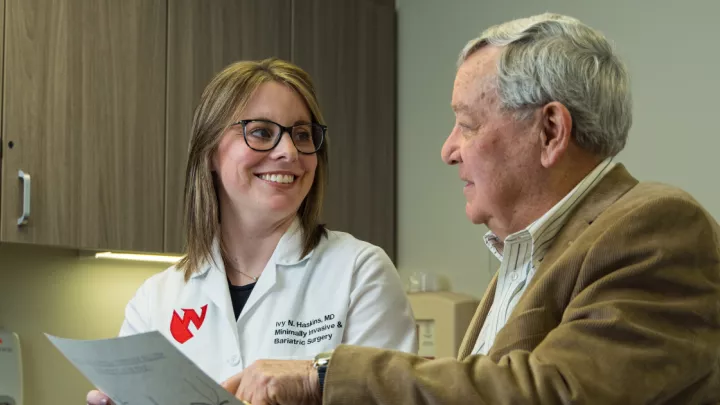What is eosinophilic esophagitis, and how is it treated?

Eosinophilic esophagitis is a chronic inflammatory condition typically brought on by certain stimuli. Some of these stimuli are specific foods we eat, as several food groups initiate an inflammatory response – similar to an allergic response – which triggers your eosinophils. Eosinophils are white blood cells that build up in the lining of the tube that connects your mouth and stomach.
“Once these eosinophils get triggered, they activate other cells – like cytokines – and other inflammatory matter that cause inflammation and scarring,” says gastroenterologist Alexander Hewlett, DO. “These issues then cause symptoms in patients with eosinophilic esophagitis.”
Symptoms of eosinophilic esophagitis
Patients with eosinophilic esophagitis may experience symptoms, including:
- Trouble swallowing.
- Atypical reflux symptoms.
- Lack of weight gain (in children).
“If these symptoms persist, this continued inflammation will cause a narrowing of the esophagus, which is the predominant symptom in most patients with eosinophilic esophagitis,” says Dr. Hewlett. “This narrowing causes trouble swallowing because patients develop rings and scar tissue in the esophagus.”
Your throat narrowing can result in food getting stuck in your esophagus for both adults and children. “Some patients can’t even swallow their spit, which is an example of how bad it gets,” says Dr. Hewlett.
Risk factors for eosinophilic esophagitis
Occasionally, eosinophilic esophagitis is associated with allergic conditions like asthma, atopic dermatitis, and similar conditions. Eosinophilic esophagitis also sometimes occurs in familial clusters. So, if your mother or father has it, there’s a chance you could develop it too.
Diagnosing eosinophilic esophagitis
Health care providers generally first diagnose eosinophilic esophagitis through clinical symptoms. After recognizing these symptoms, your provider will have you undergo an upper endoscopy. “During this procedure, we take biopsies of different parts of the esophagus,” says Dr. Hewlett. “We define eosinophilic esophagitis if you have 15 or more eosinophils in a biopsy specimen.” Through this endoscopy, your provider can see visual changes in your esophagus, like rings and white plaque.
Treatments for eosinophilic esophagitis
Some of the first ways you can treat your eosinophilic esophagitis is through lifestyle changes – like eating carefully, not eating large chunks of meat, etc. “Medical therapies for eosinophilic esophagitis typically start with an acid blocker or a proton pump inhibitor,” says Dr. Hewlett. “Sometimes we also prescribe a swallowed steroid.” Recently, the FDA approved new steroids specifically for the treatment of eosinophilic esophagitis.
Another treatment for eosinophilic esophagitis is an elimination diet, in which you must stop consuming wheat, milk, shellfish/fish, soy, eggs and peanuts/tree nuts. You then systematically add one or two of these back to your diet as a one-month challenge. Such treatment can also include working with a dietitian to eliminate foods that could be causing the problem correctly.
“Now, there’s also subcutaneous biologic therapy through a medicine called Dupixent®,” says Dr. Hewlett. “This medicine is injected into the patient to reduce inflammation and scarring in the esophagus.”
Treating eosinophilic esophagitis
“Recognizing the symptoms of eosinophilic esophagitis is very important,” says Dr. Hewlett. “If you’re having trouble swallowing, you may need an evaluation. You don’t want to put off getting your symptoms checked out.”
So, for example, if you’re having difficulty eating certain meals or foods, and they’re getting stuck, don’t ignore it. “You don’t want to be eating a large piece of meat and have it stick in your esophagus, which then necessitates an emergency endoscopy,” says Dr. Hewlett.






